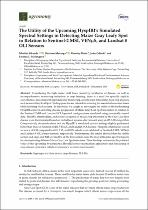The Utility of the Upcoming HyspIRI’s Simulated Spectral Settings in Detecting Maize Gray Leafy Spot in Relation to Sentinel-2 MSI, VENµS, and Landsat 8 OLI Sensors
Abstract
Abstract: Considering the high maize yield loses caused by incidences of disease, as well as
incomprehensive monitoring initiatives in crop farming, there is a need for spatially explicit,
cost-effective, and consistent approaches for monitoring, as well as for forecasting, food-crop diseases, such as maize Gray Leaf Spot. Such approaches are valuable in reducing the associated economic losses while fostering food security. In this study, we sought to investigate the utility of the forthcoming HyspIRI sensor in detecting disease progression of Maize Gray Leaf Spot infestation in relation to the Sentinel-2 MSI and Landsat 8 OLI spectral configurations simulated using proximally sensed data. Healthy, intermediate, and severe categories of maize crop infections by the Gray Leaf Spot disease were discriminated based on partial least squares–discriminant analysis (PLS-DA) algorithm. Comparatively, the results show that the HyspIRI’s simulated spectral settings slightly performed better than those of Sentinel-2 MSI, VENµS, and Landsat 8 OLI sensor. HyspIRI exhibited an overall accuracy of 0.98 compared to 0.95, 0.93, and 0.89, which were exhibited by Sentinel-2 MSI, VENµS, and Landsat 8 OLI sensor sensors, respectively. Furthermore, the results showed that the visible section, red-edge, and NIR covered by all the four sensors were the most influential spectral regions for discriminating different Maize Gray Leaf Spot infections. These findings underscore the potential value of the upcoming hyperspectral HyspIRI sensor in precision agriculture and forecasting of crop-disease epidemics, which are necessary to ensure food security

